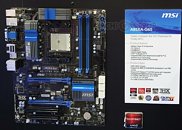Monday, June 4th 2012

MSI Shows off A85XA-G65 Socket FM2 Motherboard
MSI showed off its top socket FM2 motherboard, the A85XA-G65. Based on the AMD A85 FCH chipset, the board supports upcoming AMD "Trinity" APUs in the FM2 package. MSI designed the A85XA-G65 with its Military Class III construction. The FM2 APU is powered by an 8-phase VRM. It is wired to four DDR3 DIMM slots, supporting dual-channel DDR3-1866 MHz memory; and two PCI-Express 2.0 x16 slots (x8/x8, when both are populated). Given that it supports both NVIDIA SLI and AMD CrossFire, it's a little strange that MSI didn't name this model "A85XA-GD65." Other expansion slots include three PCI-Express 2.0 x1 and two legacy PCI.
All eight SATA 6 Gb/s ports from the A85 FCH are wired out as internal ports, with no eSATA. Display outputs include one each of DVI, D-Sub, HDMI, and DisplayPort. Other connectivity options include four USB 3.0 ports, gigabit Ethernet, and 8+2 channel HD audio. The A85XA-G65 features quite a few OC-friendly features, including voltage-measurement points with lead-holders, OC Genie, ClickBIOS II UEFI BIOS, etc. It will be among MSI's first socket FM2 motherboards to be launched, a little later this quarter.
All eight SATA 6 Gb/s ports from the A85 FCH are wired out as internal ports, with no eSATA. Display outputs include one each of DVI, D-Sub, HDMI, and DisplayPort. Other connectivity options include four USB 3.0 ports, gigabit Ethernet, and 8+2 channel HD audio. The A85XA-G65 features quite a few OC-friendly features, including voltage-measurement points with lead-holders, OC Genie, ClickBIOS II UEFI BIOS, etc. It will be among MSI's first socket FM2 motherboards to be launched, a little later this quarter.

16 Comments on MSI Shows off A85XA-G65 Socket FM2 Motherboard
And yeah...still no sign of Trinity here yet.
ITX sure, mATX, why not? full ATX? :banghead:
My point was buying an apu is for its integrated graphics therefore even getting a crossfire system is kinda pointless because ur better off investing in am3+ system or an Intel if that's the case that way u won't be paying extra for features u won't be using, and by crossfire I mean 2 discrete and gpus not dual graphics.
Tho I agree with the flexibility argument, but I won't invest into such a setup intentionally
i was talking about llano in my previous post as you now pay 130$ or something for a quad core llano, when u can pay 100 for a quad core phenom II or even a 6 core phenom II (clocked at 3.0ghz just like llano)
and llano cores are based on the same cores as phenom II so higher clockspeed = better performance and more cores also = better performance
i didnt mention the quad core bulldozers as some people might not like these chips
but at micro center you can a 6core bulldozer for 120 dollars, still cheaper than the llano apu's and overclock much better so even though ipc is lower the clock speed might make it up
www.microcenter.com/specials/promotions/AMDbundlePROMO.html
now do you see my point?
why pay extra for the onboard graphics when you will not use it?
though its important to note that AM* piledrivers will come months after trinity and the FM2 platform, so yes within that period your argument is valid and trinity apus might offer the best cpu performance from AMD.
if thats what you mean well lets just say that extra bandwidth is to feed the gpu and doesnt affect the cpu performance, remember phenom II has L3 cache but llano doesnt
however over all the llano in some cases was like 7% faster clock-clock than phenom II which isnt anything to be mentioned
@7%
I'm looking too. Link me if you can find a review that did a crossfire/sli config with Llano.
Because if so then again the desktop am3+ platform has more PCI e lanes than fm2/fm1 therefore lets you crossfire sli with multiple cards running at 16x each(that's on 990fx chipset) while in fm2 you get a max of 24lanes with 16x on one and 8x on the other or 8x 8x 8x I'm not aware on how different vendors will use such configurations but in general my point is if that is your concern then know that am3+ has the edge there
As for IMC that has to do with cpu connectivity with the ram and between phenom II and llano is a huge improvement but is only to feed the gpu and doesn't affect over all performance
www.hardwarecanucks.com/forum/hardware-canucks-reviews/44339-intel-core-i3-2120-core-i5-2400-lga1155-processors-review-2.html
It has been said that the Sandy Bridge lineup has the strongest IMC. Difference between 16x and 8x 2.0 would be very very minimal loss (not exactly what I was trying to mention). Also I understand the A8-3850 is near the bottom, but at this time I cannot find any benchmarks/reviews of current fm1 chips that was paired with 2 dedicated cards for multi gpu to show how it stacks up against everything else.
However all these factors shouldn't be compared as a deciding factor because each architecture is different. For example the bulldozer/piledriver architecture have higher cache latencies than phenom or sandy bridge because the architecture was designed for higher frequency throughput. Had it been that everything was faster with lower latencies and short integer pipelines then the shared resources would not be able to feed two integer cores with acceptable scaling and the cores would have shorter cycles but will be starved when both are running. Offcourse the architecture can still be fine tuned which is what amd has been doing